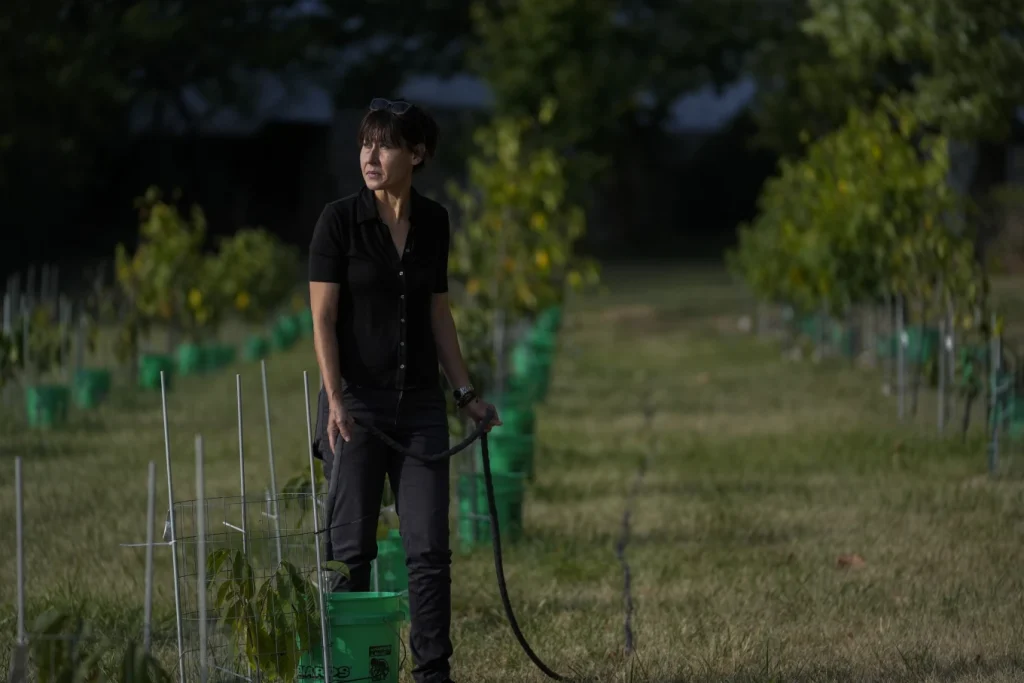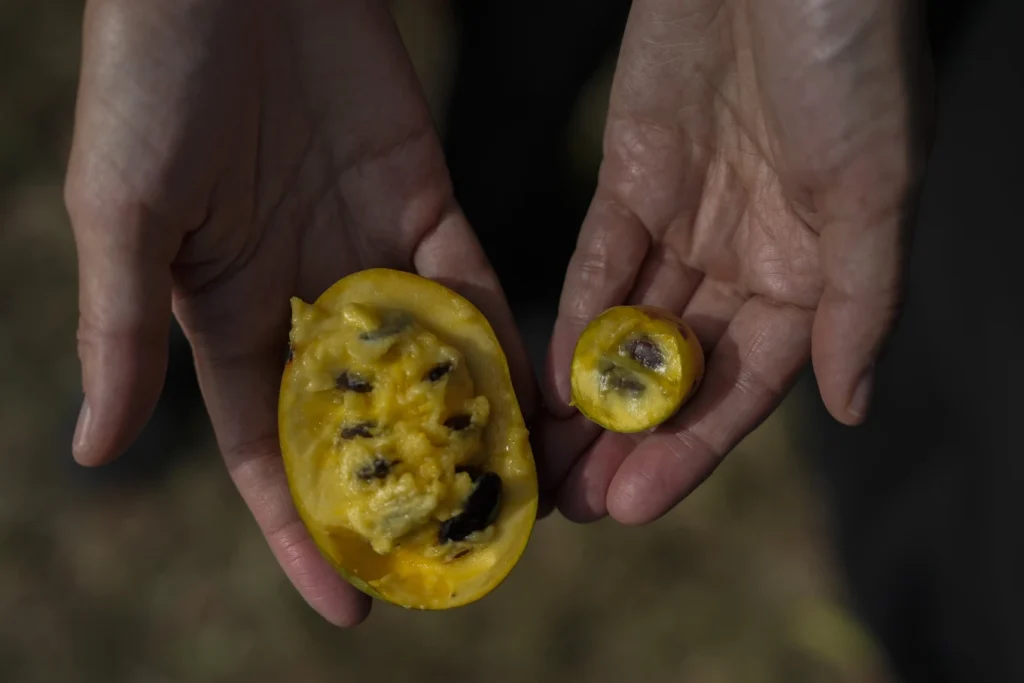The pawpaw, a unique fruit native to North America, is experiencing significant challenges as a result of climate change and erratic weather patterns.
This essay explores the current state of pawpaw cultivation in Ohio, particularly in the context of prolonged drought conditions and other climatic shifts that are reshaping agricultural practices and fruit quality.
The pawpaw, often likened to a cross between a mango and a banana, is not only cherished for its distinctive flavor but also holds cultural and economic significance in regions where it is grown.
However, the increasing unpredictability of weather patterns poses a threat to its cultivation, particularly in areas like Washington Court House, Ohio, where growers are grappling with the consequences of these environmental changes.
The pawpaw tree (Asimina triloba) thrives in the eastern half of North America, from Ontario to Florida, and Ohio is recognized as a significant region for its cultivation.
Each year, the state hosts an annual pawpaw festival that celebrates this underappreciated fruit. However, the recent experiences of growers like Valerie Libbey and Chris Chmiel illustrate the profound impact of climate change on pawpaw production.
Libbey, who manages an orchard in Washington Court House, reported an unusually early harvest this year, with fruits dropping from trees as early as the first week of August, a stark deviation from the typical mid-September timeline.
This change not only shortens the harvest period but also affects the quality of the fruit, which has been described as smaller and more bitter than in previous years.
Such alterations in the pawpaw’s growth cycle can be attributed to a combination of heat stress and prolonged drought, which have become more prevalent in Ohio and Kentucky over the past few years.
The effects of climate change on pawpaw cultivation are not isolated incidents but rather part of a broader trend affecting agriculture in the Midwest.
According to the National Climate Change Assessment, extreme weather events such as droughts and flooding are increasingly threatening crop yields and livestock production in the region.
The changing climate has led to earlier flowering times for pawpaw trees, a phenomenon noted by horticulture professor Kirk Pomper at Kentucky State University.
The shift in flowering patterns is indicative of the broader ecological disruptions that are occurring as a result of climate change.
This unpredictability presents significant challenges for growers who rely on consistent weather patterns to ensure successful harvests.
Chmiel’s experience further underscores the vulnerability of pawpaw trees to erratic weather conditions. He has witnessed a decline in his pawpaw population from several hundred trees to approximately one hundred due to a combination of extreme wet weather followed by severe drought.
Pawpaw trees, while generally low-maintenance, are sensitive to prolonged waterlogging, which can damage their roots and lead to increased susceptibility to pests.
In Chmiel’s case, the stress placed on older trees by erratic weather patterns has attracted invasive beetles, compounding the challenges faced by growers.
These beetles thrive on trees that are under duress, leading to further declines in pawpaw populations and threatening the viability of future harvests.
The implications of these environmental changes extend beyond the immediate challenges faced by growers. The pawpaw’s limited shelf life has already made it a rare find in grocery stores across the United States, and if current trends continue, the fruit may become even less accessible to consumers.
The economic viability of pawpaw cultivation is at risk, as growers may find it increasingly difficult to produce high-quality fruit in the face of climate-induced stressors.
Furthermore, the cultural significance of the pawpaw, particularly in regions that celebrate its heritage, may be jeopardized as traditional growing practices are disrupted.
In conclusion, the plight of the pawpaw in Ohio serves as a microcosm of the broader challenges faced by agriculture in the era of climate change.
The experiences of growers like Valerie Libbey and Chris Chmiel highlight the urgent need for adaptation and resilience in the face of shifting weather patterns.
As extreme weather events become more frequent and unpredictable, it is imperative for agricultural stakeholders to develop strategies that mitigate the impacts of climate change on crops.
This may involve investing in research to better understand the ecological needs of pawpaw trees, implementing sustainable farming practices, and advocating for policies that address the root causes of climate change.
The future of the pawpaw, and indeed many other crops, depends on our collective ability to navigate the complexities of a changing climate and ensure the sustainability of our agricultural systems for generations to come.
The challenges faced by pawpaw growers in Ohio, as highlighted in the recent report on the impact of drought and shifting weather patterns, underscore a broader concern regarding the resilience of agricultural systems in the face of climate change.
The pawpaw, a fruit that is not only native to North America but also holds significant culinary and cultural value, is now experiencing alterations in its growth patterns and fruit quality due to these environmental stressors.
The observations made by Valerie Libbey regarding the premature dropping of fruit and the noticeable changes in taste and size are particularly alarming.
Such variations not only affect the individual growers but also have implications for the local economy and the cultural heritage associated with pawpaw cultivation, especially in regions that celebrate the fruit through festivals and community events.

The fact that these changes are attributed to a combination of heat stress and prolonged drought highlights the complex interplay of factors that must be considered when assessing agricultural viability in a changing climate.
Moreover, the insights from Kirk Pomper and Chris Chmiel regarding the unpredictability of weather patterns further emphasize the urgent need for adaptive strategies within the agricultural sector.
The historical consistency of pawpaw yields, as noted by Chmiel, is being undermined by extreme weather events that disrupt not only the growth cycles of the trees but also their overall health.
The mention of invasive beetles as a consequence of environmental stress adds another layer of complexity, illustrating how interconnected these challenges are.
As we move forward, it is imperative that both policymakers and agricultural experts collaborate to develop comprehensive strategies that address these climatic challenges.
This could involve investing in research to understand the specific needs of pawpaw trees under changing conditions, promoting sustainable agricultural practices that enhance resilience, and providing support to local farmers who are facing these unprecedented challenges.
In conclusion, the plight of the pawpaw in Ohio serves as a poignant reminder of the broader implications of climate change on our food systems.
It calls for a concerted effort to safeguard not only this unique fruit but also the livelihoods of those who cultivate it, ensuring that future generations can continue to enjoy and celebrate North America’s largest native fruit.
